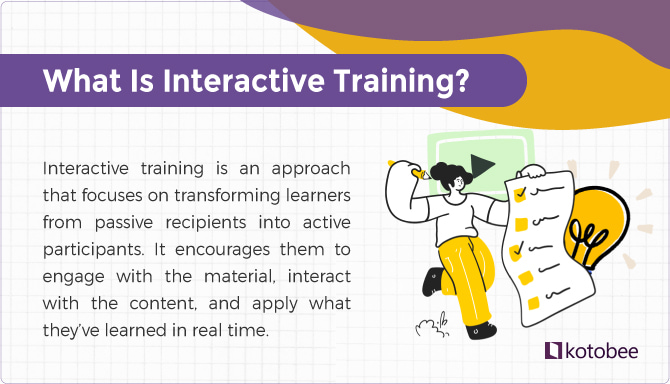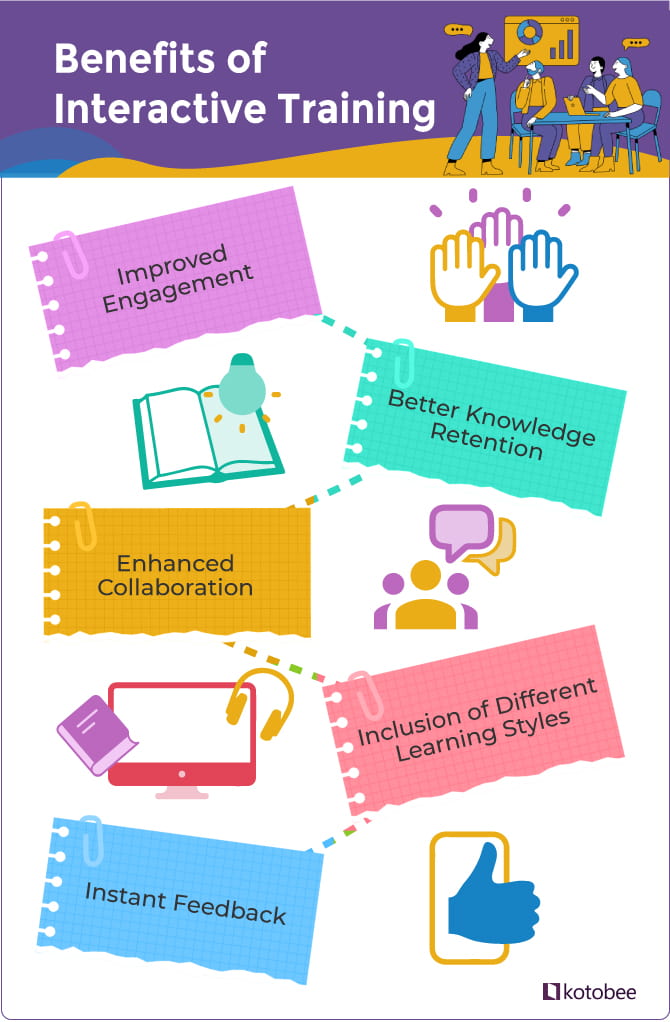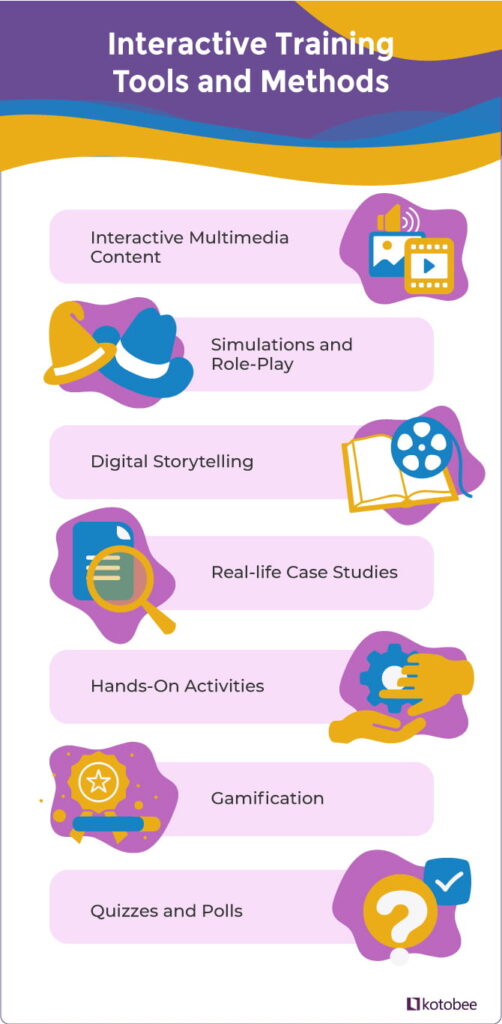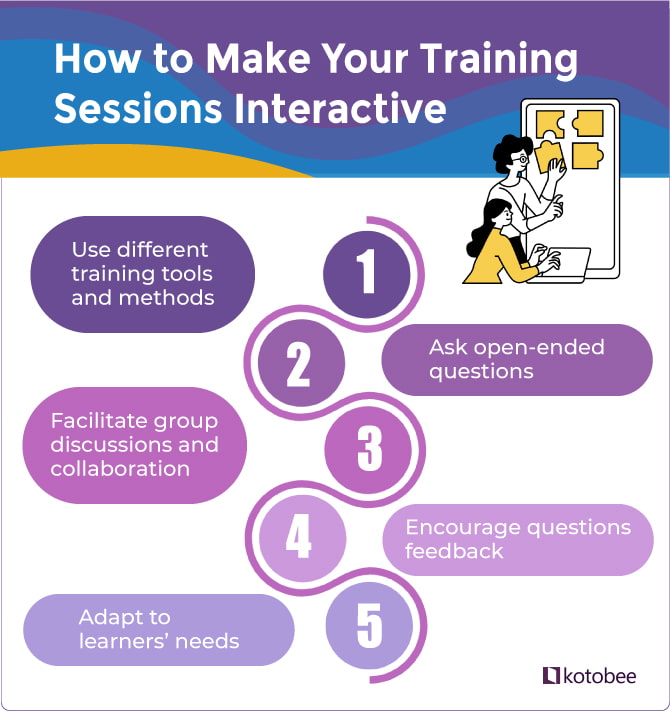How to Apply Interactive Training in the Workplace
Have you ever attended a training session so boring that you found yourself fighting off sleep? The trainer just kept talking, and by the end, you didn’t feel like you’d learned anything. Many of us have experienced this situation, where instead of being engaged in the training, we were mere observers.
If you are a trainer, you can prevent your learners from having a similar experience by switching to interactive training. In fact, studies indicate that using interactive activities, discussions, and AI edtech tools can result in better academic outcomes when compared to those of traditional lecturers.
Does this sound like something you would like to apply to your training sessions? Then keep reading! In this article, we’ll explore what interactive training is, what its benefits are, and how you can create an engaging learning environment using the right tools.

What Is Interactive Training?
The main idea behind interactive training is transforming learners from passive recipients of educational information into active participants who engage with both the learning instructor and the learning materials. Rather than just reading text or listening to lectures, they learn through hands-on activities, simulations, quizzes, or discussions. Learners are also encouraged to participate throughout the training session, interact with the content, and apply knowledge in real time.

Benefits of Interactive Training
In addition to making learners active participants in the learning process, interactive training can yield many benefits when applied effectively. Here are some of the advantages you can expect after implementing this training approach:
- Improved engagement: The interactive aspect of interactive training helps capture your learners’ attention and keep them actively involved in the training process. Using interactive content, such as quizzes, discussions, and simulations, can improve engagement by up to 52.6%!
- Better knowledge retention: Incorporating hands-on activities into the training can significantly improve knowledge retention for your learners. For example, using simulations, role-playing, or quizzes can reinforce the learning material, turning short-term knowledge into long-term memories.
- Enhanced collaboration: An important aspect of interactive training is discussion and group activities. This can encourage teamwork, communication, and knowledge sharing among your learners.
- Adapting to different learning styles: Since not all learners can comprehend the learning materials in the same way, interactive training can be a good way to incorporate various methods—such as visual aids, hands-on activities, and auditory explanations. Thus, this approach makes content more accessible and ensures that everyone can easily engage with and absorb the learning material.
- Instant feedback: Unlike traditional methods, interactive training uses tools (like quizzes or simulations) that provide learners with instant feedback. By receiving instant responses, learners can quickly identify their strengths and areas for improvement.

Interactive Training Tools and Methods
The tools and methods you choose to deliver your training material can greatly impact how well your trainees absorb and apply what they learn. And since interactive training focuses on actively engaging learners, it’s important to use the most effective strategies. For that reason, we’ve put together a list of tools and methods that can make your training sessions more impactful:
- Interactive multimedia content: Using interactive content creation software, such as Kotobee Author, you can provide your trainees with learning materials that are rich with videos, animations, and interactive infographics. These elements can make difficult concepts more engaging and easier to understand.
- Simulations and role-play: Simulations and role-playing are two of the best methods that can make your training both beneficial and captivating for your learners. They allow them to practice job-related skills and make decisions in a controlled environment.
- Storytelling: Stories can help your trainees learn and remember facts more efficiently. For example, you can use them in your training to teach your learners how to interact with customers or peers appropriately. Additionally, introducing interactive storytelling can add an element of gamification to your training.
- Real-life case studies: Present learners with case studies relevant to their field or interests. By analyzing and solving real-life problems, they will be able to see the different practical applications of the concepts they’ve learned during the training.
- VR and AR: For more advanced training, such as in the medical field, using VR and AR can create immersive experiences that simulate real-world environments and scenarios. Not only will they help improve your learners’ engagement, but they can also have a great impact on knowledge retention and practical application.
- Hands-on activities: Design activities that require learners to physically interact with the learning materials or complete tasks. This could include building models, conducting experiments, or using interactive software.
- Gamification: Adding game-like elements (such as points, badges, and leaderboards) to your training can make the learning process more enjoyable and motivating. Introducing these features encourages friendly competition and boosts engagement by rewarding your learners for their progress and achievements.
- Quizzes and polls: Include quizzes or polls to check your learners’ understanding of the training materials and keep them engaged. Having instant feedback can reinforce learning and highlight areas that need more attention or further discussions. Moreover, giving your learners the chance to assess their progress through self-assessment tools can help them track their own growth, which in turn can help them stay motivated.

How to Make Training Interactive
Now that you know what interactive training is and its benefits, it’s time to get down to business. Making your training interactive may seem daunting from afar, but when broken down into practical steps, the whole process becomes much easier. To help you with that, we have some interactive training ideas that can make the learning experience both dynamic and enjoyable for your learners.
1. Diversify Your Training Tools
To make your training sessions truly interactive, you have to use a variety of methods and tools. Switching up your techniques can keep your learners engaged and motivated, and can also ensure they remain interested and active throughout the session.
Moreover, using different training approaches can help address diverse learning styles; some learners thrive with hands-on activities, while others connect more with digital content or simulations. By mixing up your training methods, you create a more inclusive environment where everyone can absorb the material in a way that works best for them.
2. Ask Open-Ended Questions
One of the effective techniques you can use to turn your learners from passive recipients into active participants is by including open-ended questions. This type of questions can help your learners think critically and apply their knowledge. For example, when presenting a case study, avoid having yes and no questions. Instead, ask them how they would behave in such a situation. What do they think is the best approach to handle such an issue? Or what would they have done differently?
Moreover, open-ended questions give your learners the opportunity to share their personal experiences and insights. This can help foster a deeper connection with the material while allowing them to learn from each other. As a result, you’ll be able to encourage diverse perspectives and create a more dynamic and inclusive learning environment.
3. Facilitate Group Discussions and Collaborations
Encouraging your learners to engage in group discussions and collaborative activities can really bring your training sessions to life. When people work together, they share ideas and naturally build their communication skills. Studies show that learning in groups can have a huge impact on knowledge retention rates, compared to learning alone! The reason is that when learners talk through concepts and solve problems together, they tend to remember and understand the training material better.
Group work also helps foster important skills like teamwork, creativity, and problem-solving. Depending on your session’s goals, you can have learners work in pairs, small groups, or even larger teams. You could also try different approaches like brainstorming sessions, peer feedback, or project-based learning to get them collaborating in a more interactive way.
4. Encourage Questions and Feedback
As we mentioned earlier, your training sessions should be more of an interaction than a monologue where you’re the only one speaking. That is why it is very important to create a learning environment where participants can freely ask any questions they might have about the training materials. This openness can help address their specific needs while ensuring that the training remains relevant and impactful.
Just like allowing questions from your learners is important, so is providing them with feedback. When delivered in a constructive way, it can help your learners improve their performance, recognize their strengths and weaknesses, and set meaningful goals. How you choose to deliver this feedback depends on the nature of your training sessions as well as your learners’ preferences and needs. For example, it can be done individually or collectively, formally or informally, during or after the sessions.
5. Adapt to Your Learners’ Needs
As a trainer, getting to know your learners’ educational backgrounds, expectations, motivations, and challenges is important. You also need to accept their feedback, questions, and suggestions with an open mind. Because when you tailor your content and teaching methods to match their learning goals, you create a training experience that’s not only more personalized but also more engaging for each individual.
Besides that, being responsive to their needs helps create a stronger sense of connection and support. This approach can encourage them to become active participants, which will transform your training into a vibrant, interactive environment where everyone feels valued and truly understood.

How to Create Interactive Training Using Kotobee
Having the knowledge of how to make your training interactive is only the first step. What you need now is a tool that will make it all come to life, and that is where Kotobee Author comes in. This AI-powered course creation software allows you to add many elements to your training materials to make it truly interactive.

After downloading the software and importing your training content, you can include some (or all) of the following interactive elements:
- Multimedia content: Enrich your training materials with various multimedia content using Kotobee Author. Whether it’s videos or images, you can either upload your own or choose from a free library that provides everything you need. Additionally, you can add your own audio tracks or recordings.
- Games and mini-apps: Adding the gamification element to your training can be easily done using Kotobee mini-apps. You’ll find various games, such as chess, memory games, and more, which you can tailor to meet the objectives of your training.
- Quizzes and feedback forms: Since assessing your learners’ progress is crucial in interactive training, Kotobee Author allows you to add various types of quizzes, surveys, and forms throughout the learning materials. Not only that! You can also use Kotobee’s AI content creation tool to generate any type of quiz you might need in just a few seconds.
- Interactive stories: Let’s say you want to present your learners with different scenarios and see how they’ll act. This can easily be done using interactive storytelling, which you can create in Kotobee Author. Using anchors and two-way links, you can let your learners choose any scenario they like and explore different outcomes based on their decisions.
Once you have made your training content truly interactive, you can now easily export it to any format you’d like. For example, you can export it as a mobile or desktop app with your brand colors and logo, or you can directly integrate it into your organization’s learning management system.
Wrapping Up
As you apply interactive training, remember that the ultimate goal is to create an experience where your learners gain knowledge and also enjoy the process. By incorporating hands-on activities, real-life scenarios, and instant feedback, you will be able to create a dynamic environment where your learners thrive.
Luckily, tools like Kotobee Author can make this transformation easier by offering a range of interactive features that help you deliver unique training sessions to your learners. So, take the plunge today and turn your training sessions into immersive, interactive experiences that drive real results!
.
Read More
Online Training for Employees: Top Benefits, Methods, and Tools
How to Choose the Best LMS for HR Training
Best Microlearning Platforms and Tools for Employees















